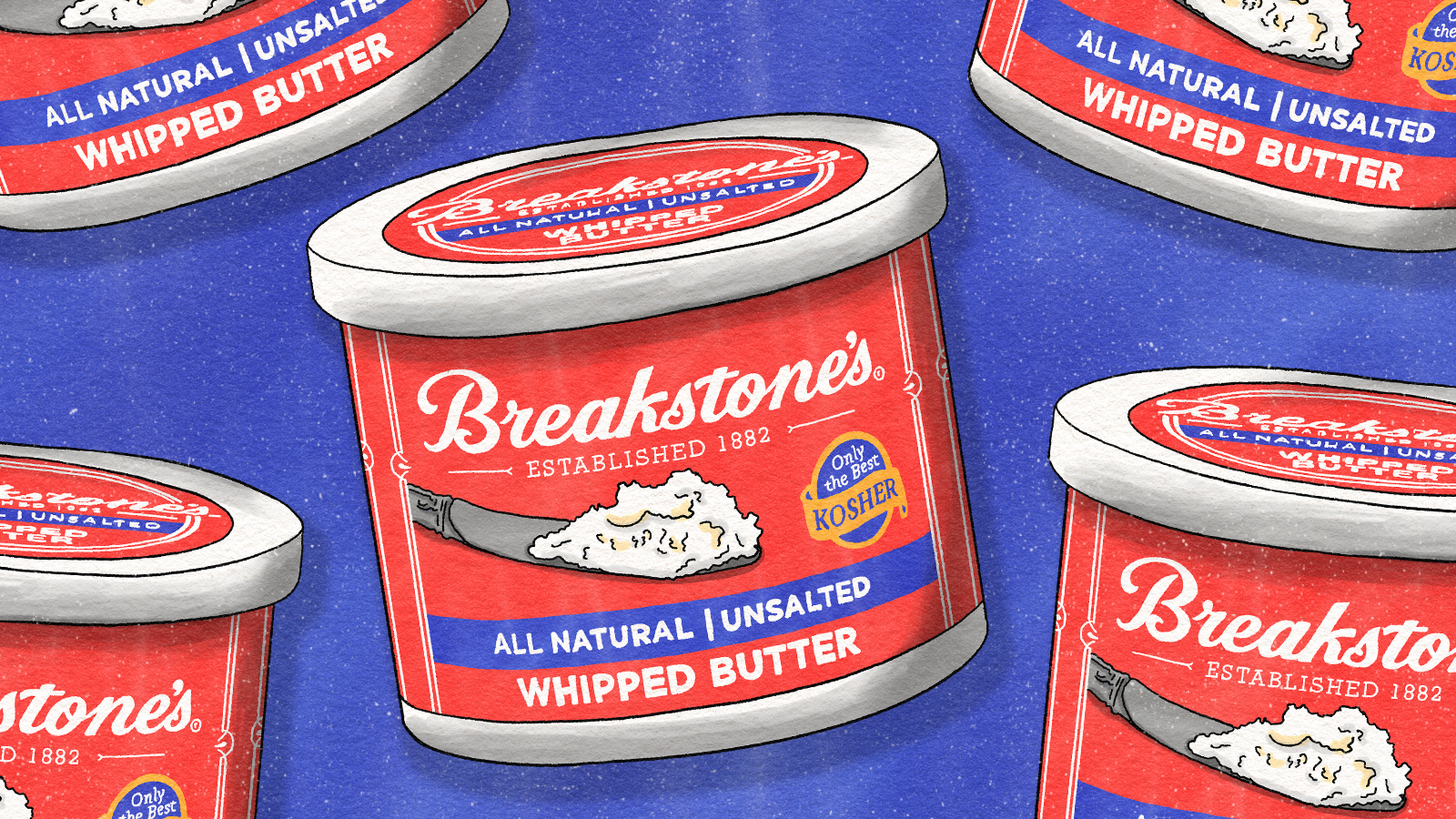“Sam Breakstone, get out of the tub!” It’s a phrase I hear in my head every time one of my kids spends too long in the bathtub, their fingers pruny, and at least a pint of soapy water spilled on the floor. The phrase comes from a 1997 ad for Breakstone’s cottage cheese, in which Sam Breakstone has one of his signature epiphanies — this time, to take his cottage cheese out of their tubs and into individual containers, for freshness. Throughout the 1980s and 90s, Sam Breakstone entered the homes of millions of Americans through dozens of ads, but his very existence and the history of the brand touted on the tubs themselves is something of a ruse.
Founded in the late 1800s by a pair of Jewish immigrant brothers, Joseph and Isaac Breakstone (originally Bregschtein) from Panemuné, Lithuania, Breakstone’s dairy products — especially butter — are synonymous with Passover. To this day, their butter is the only certified kosher for Passover butter on the market. But the exact origins of this Jewish-owned brand are the subject of some debate. Despite the fact that Breakstone’s products proudly proclaim “Established 1882” on every product, the likelihood of the business being founded that year is incredibly low, according to Jordon Davis, the author of the blog “Finding Sam Breakstone.”
Citing Rabbi Jeffrey Marx, a scholar of dairy products and a direct descendent of the Breakstone’s family, Davis shows that Joseph Breakstone immigrated sometime between 1878 and 1882. Isaac followed in 1882. For a few years after that, the two worked as peddlers, possibly living in Pennsylvania. By 1885, they were back in New York, where Joseph opened a grocery store at 27 Orchard Street in Manhattan. Isaac continued to peddle dry goods until 1888, when he entered the dairy market, selling milk and other dairy products. Over the next couple of years, the Breakstone family built their reputation in the world of dairy, with both brothers as well as cousins Morris and Hyman, owning stores of their own.
It wasn’t until 1897 when the family came together under one retail roof, with Joseph, Isaac and Morris starting Breakstone Brothers, a grocery selling fresh food, including dairy products, on the Lower East Side of Manhattan. They copyrighted the name in 1906, and in 1907, they began manufacturing dairy products at a small plant in Brooklyn.
The Nosher celebrates the traditions and recipes that have brought Jews together for centuries. Donate today to keep The Nosher's stories and recipes accessible to all.
According to a 1982 article in The Anniston Star, “At a time when most American housewives were still churning their own butter and making their own soft cheeses, the brothers brought convenience to their customers. They sold butter from big wooden tubs, dipping scoops to order.” The company was among the first to use trucks to deliver their products. A “cream cheese box spectacular” manufactured by Hoover Bros and Graham Body was made exclusively for Breakstone’s.
In 1912, Breakstone’s began manufacturing from a facility in Walton, NY, allowing them to ramp up production considerably. This would be the location referenced on Breakstone’s packaging for many years: “1882, Walton, NY,” though it reflects neither the true origin of the brand nor the original location. During WWI, Breakstone’s was the largest producer of condensed milk for the armed forces. Then in 1920, the family began to mass market their products to consumers, finally making soft cheeses and other dairy products affordable for the average Jewish consumer, according to Rabbi Marx.
In 1925, Breakstone’s began designating their products as kosher, as mass production opened them up to a largely Jewish audience who could afford their products for the first time. “They are marketing specifically for a Jewish clientele,” Marx explains. “Even their ads in the Jewish Forward are pitched toward Jews. They’re in Yiddish, and they suggest substituting Breakstone’s cream cheese to make all sorts of traditional Jewish dishes. The ads say things like, ‘Your blintzes will taste better when you use Breakstone’s cream cheese.’”
Though the exact timing of the kosher for Passover designation for Breakstone’s products is unknown, Marx references his own collection of Breakstone’s memorabilia (on display at the National Museum of Jewish History in Philadelphia), citing two boxes from 1930 with rabbinic hechshers noting that they are kosher for Passover. These are the earliest examples of the designation Marx has found in his research.
Fifth generation family member Warren Breakstone, another genealogy hobbyist and collector of Breakstone’s memorabilia echoes Marx, saying, “This was a Lower East Side brand, so they were catering to those early customers, and that became an early niche that continues to this day.”
Having grown the business to a regional level by 1928, Joseph and Isaac sold the business to National Dairy Products, a huge conglomerate of dairies and distribution centers that went on to merge with Kraft-Phenix. Joseph retired at the time of the sale, passing away two years later. Isaac, however, continued to serve as the chairman of the board until his death in 1945. Under National Dairy, Marx explains, the brand flourished, finally becoming the household name it is today.
In 1977, another Breakstone was born, so to speak. Sam Breakstone, the persnickety, dairy-obsessed figure that became synonymous with the brand, was created by the Richard K. Manoff Inc. marketing group for Kraft, likely to appeal to consumers by referencing the high standards of what was known as a family brand, though the family was long removed from the business by then.
Played by Sam Vale (the same actor who portrayed Dunkin’s Fred the Baker), the long suffering dairyman routinely berates his employees, attempting to make a perfect product while being attacked by his dog, a Jack Russel Terrier named Jake. “But if Sam weren’t so demanding,” the ads said, “his cottage cheese (or sour cream, depending on the commercial) wouldn’t be so good.” The commercials featured a fictitious storefront located on Sullivan Street between Houston and Prince, about a mile and a half from the original Breakstone grocery store.
In 1981, Kraft published a slim cookbook called “Sam Breakstone’s Favorite Recipes,” which included just under 30 dairy-based recipes, like Mrs. Breakstone’s Coffee Cake and something called Sam’s Corny Casserole, a warmed up heart attack of corn and zucchini suspended in sour cream, cottage cheese and butter. The fictitious Breakstone continued to represent the brand well into the 1990s, until Vale retired in 1997.
Though the family had long since gone on to other pursuits by the time of his commercials, Sam Breakstone carried the family name and reputation forward for new generations to identify with and enjoy (irascible though he was). After several sales, mergers and reports of declining dairy sales, Kraft (now the Kraft Heinz Company) sold Breakstone’s to Lactalis in 2020, as part of a larger restructuring. No longer involved directly in the business, descendants like Warren Breakstone and Rabbi Marx still take an unmistakable tone of pride when recounting the history of this immigrant-founded family business, one known for high standards and high quality.



